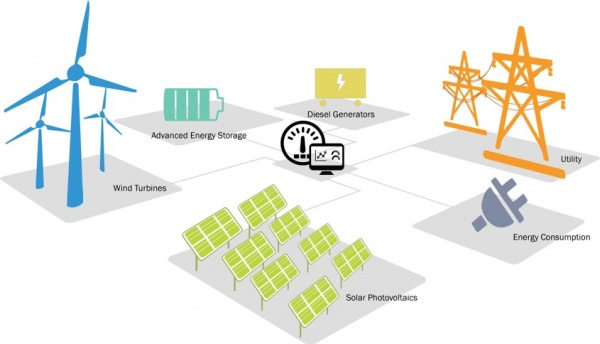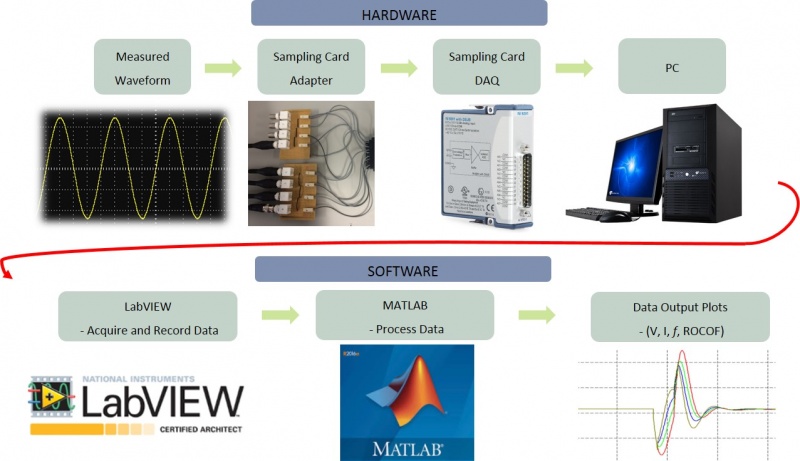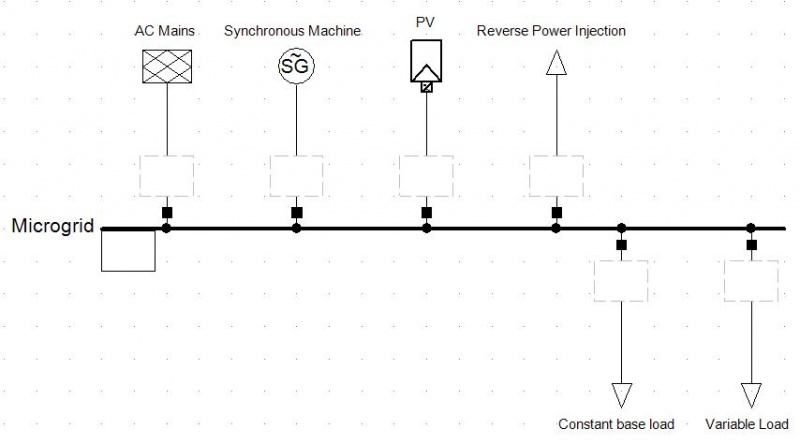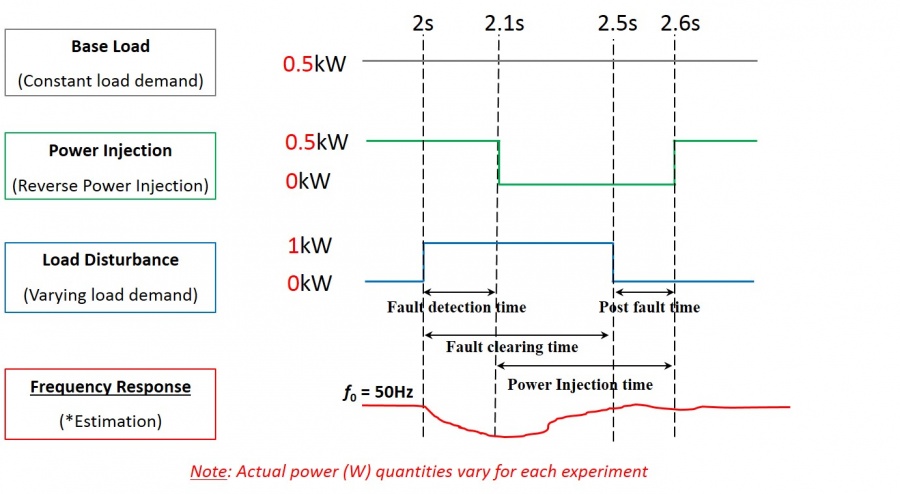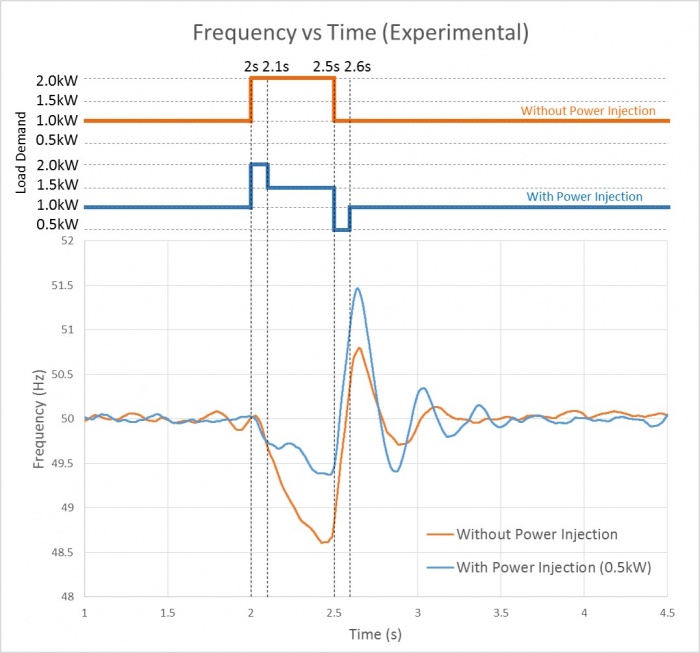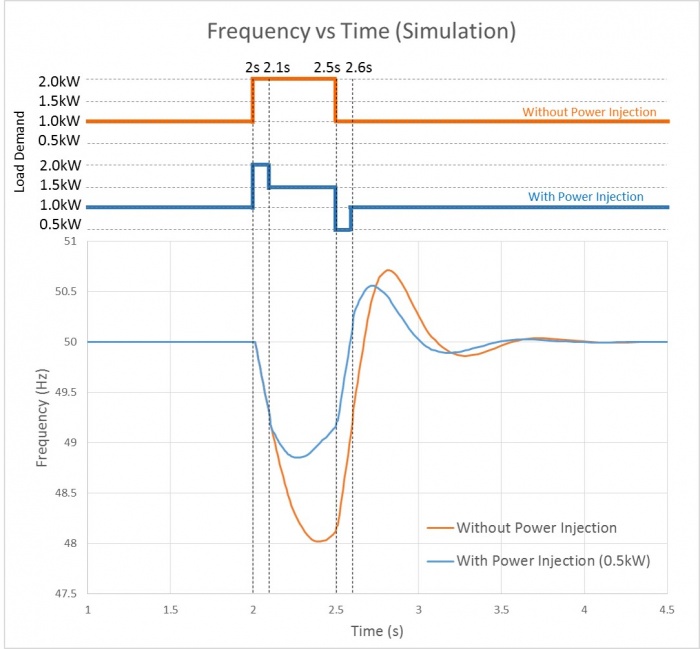Projects:2017s1-106 Inertia Characterisation and Modelling in a Renewable Energy-based Microgrid
Contents
Introduction
Project Description
Project 106 - Inertia Characterisation and Modelling in a Renewable Energy-Based Microgrid
This project involves the next phase development of a renewable microgrid experimental testbed at the UoA, featuring microgrid dynamic modelling simulation work using PowerFactory, a sophisticated computer-aided engineering tool for the analysis of electrical power systems.
Experimental aspects incorporate battery energy storage into a microgrid to study the steady-state and dynamic properties of energy storage in maintaining demand-supply balance as well as performing dynamic stabilisation to study the effects in the context of a large mega-grid for future research and development. Frequency measurement and processing systems have been developed using a combination of sampling hardware and programming software, primarily LabVIEW and MATLAB. Key findings indicate benefits and limitations of battery storage systems in providing Fast Frequency Recovery by means of Fast Power Injection.
Recent developments of the SA Power Grid with one of the highest renewable energy penetration rates in the world, currently at 50%, and the lowest relatively system inertia of the country, highlight the relevance of this project with experimental and simulation model development of battery storage systems and microgrid capabilities. Future projects may explore voltage stability control, improved frequency measurement techniques and further frequency stability control aspects.
Microgrid Example [1]:
Project Team
- Adam Portelli
- Hosoo Yoon
Project Supervisors
(University of Adelaide)
- Associate Professor Nesimi Ertugrul
(ElectraNet, Sponsor)
- Dr Wai-Kin Wong
Motivation
South Australia
- Renewable energy penetration ≈ 50% (World Leaders).
- Currently have the lowest relative system inertia of the country.
Renewable energy sources , such as PV and Wind
- Do not provide traditional system Inertia.
- Intermittent/variable supply.
- Currently posing power grid stability threats.
So, there is a need for a long-term solution...
- Battery storage systems may be a key part of the solution!
Objectives
- Next phase development of a Renewable Energy-Based Microgrid
- Adding new battery storage system.
- Developing a DAQ Measurement and Frequency Processing System.
- Development and validation of a software model using PowerFactory.
- Through testbed experiments and software simulations, show that added battery storage systems can:
- Reduce Rate of Change of Frequency (RoCoF) during grid disturbances by providing synthetic inertia.
- Provide fast frequency recovery (FFR).
Project Design
DAQ and Frequency Processing System
- LabVIEW has been implemented to form the sampling capability system used in this project to record grid data.
- National Instrument sampling and I/O cards have been utilized for data capture and control of the electronic load hardware devices via LabVIEW.
- Software processing using MATLAB has been developed to aid in the analysis of experimental data and the comparison with software model data.
- The process model below shows the DAQ Measurement and Frequency Processing System flow diagram:
Hardware Testbed
The project considers four individual testbeds to allow for different grid elements to be studied individually:
- Testbed #1: AC Mains Grid, Load
- Testbed #2: Generator Grid, Load
- Testbed #3: Generator Grid, PV, Load
- Testbed #4: Generator Grid, Battery System, Load
The final experimental testbed 4 shown below consists of a 3.4kVA Portable Synchronous Generator, a DC power simulated Solar PV system, conventional base load, variable Dynamic Electronic loads, and a Battery Storage System which has been simulated via a Reverse Power Injection system using a Dynamic Electronic load.
Software Model
The software model was designed using PowerFactory by DigSILENT. Power Factory is a sophisticated computer-aided engineering tool for the analysis of transmission, distribution, and industrial electrical power systems, primarily for the analysis of large power systems.
- PowerFactory was utilized as it has dynamic power system simulation capabilities which is a key focus in this project.
- The PowerFactory software model has been developed and validated to represent the experimental testbed.
- The key challenges of the software model include adjusting the generator governor parameters and calculating inertia parameters to match the characteristics of the physical generator.
- The software model shown below incorporates all four individual testbeds, simulated via real-time switch control.
Reverse Power Injection Method
The following diagram shows the method used to achieve Reserve Power Injection in the Microgrid via control of the Electronic Loads.
Project Results
- The frequency response demonstrates that Power Injection reduces the RoCoF, frequency dip and frequency recovery time, but as a trade-off increases overshoot.
- A 0.5kW Power Injection for a 1kW grid disturbance reduced the frequency dip by ≈ 0.8Hz and RoCoF by ≈ 4Hz/s, which has the effect of increasing the level of system inertia by approximately three times.
- Power Injection thus is shown to provide Fast Frequency Recovery (FFR) by delivering synthetic inertia to the grid.
- Critical factors such as RoCoF, frequency dip and steady-state recovery time are well matched for both the experimental and simulation test cases, however the experimental results show a larger overshoot due to the governor control characteristics of the portable generator.
Project Conclusion
Key Achievements
- Development of a complete hardware experimental testbed
- Development of an accuracy verified DAQ Measurement and Processing System
- Development and validation of a PowerFactory software model
Complexities and Solutions
- Frequency measurement limitations due to distorted waveform produced by the portable generator - resulting in two-cycle frequency measurement compensation
- Inverter synchronization complexities - utilization of reverse power injection via electronic load
- Experimental testbed software modelling – using the power swing equation and provided governor models to calculate and match generator parameters
Key Outcomes
- Demonstrated that battery storage systems can:
- - Reduce RoCoF during grid disturbances
- - Deliver synthetic inertia to a microgrid
- - Provide Fast Frequency Recovery
Future Project Recommendations
Future project may focus on aspects involving:
- Grid voltage stability control during power injection
- Improved frequency processing techniques
- Further FFR control methods including optimal fault detection time, power injection duration and ramping levels
- Upgraded generator capabilities incorporating a pure sine wave output to allow for grid-tied inverter synchronisation
References
[1]: "Microgrid Technology – Cleanspark". Cleanspark.com. N.p., 2017. Web. 22 Mar. 2017
